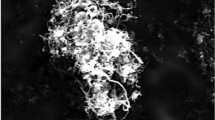Abstract
Sn-Ag-Cu solder is a promising candidate to replace conventional Sn-Pb solder. Interfacial reactions for the flip-chip Sn-3.0Ag-(0.5 or 1.5)Cu solder joints were investigated after aging at 150°C. The under bump metallization (UBM) for the Sn-3.0Ag-(0.5 or 1.5)Cu solders on the chip side was an Al/Ni(V)/Cu thin film, while the bond pad for the Sn-3.0Ag-0.5Cu solder on the plastic substrate side was Cu/electroless Ni/immersion Au. In the Sn-3.0Ag-0.5Cu joint, the Cu layer at the chip side dissolved completely into the solder, and the Ni(V) layer dissolved and reacted with the solder to form a (Cu1−y,Niy)6Sn5 intermetallic compound (IMC). For the Sn-3.0Ag-1.5Cu joint, only a portion of the Cu layer dissolved, and the remaining Cu layer reacted with solder to form Cu6Sn5 IMC. The Ni in Ni(V) layer was incorporated into the Cu6Sn5 IMC through slow solid-state diffusion, with most of the Ni(V) layer preserved. At the plastic substrate side, three interfacial products, (Cu1−y,Niy)6Sn5, (Ni1−x,Cux)3Sn4, and a P-rich layer, were observed between the solder and the EN layer in both Sn-Ag-Cu joints. The interfacial reaction near the chip side could be related to the Cu concentration in the solder joint. In addition, evolution of the diffusion path near the chip side in Sn-Ag-Cu joints during aging is also discussed herein.
Similar content being viewed by others
References
K.S. Bae and S.J. Kim, J. Mater. Res. 17, 743 (2002).
H.W. Miao and J.G. Duh, Mater. Chem. Phys. 71, 255 (2001).
D.R. Frear, J.W. Jang, J.K. Lin, and C. Zang, JOM 53, 28 (2001).
B.L. Young, J.G. Duh, and B.S. Chiou, J. Electron. Mater. 30, 543 (2001).
K. Suganuma, Curr. Opin. Solid State Mater. Sci. 5, 55 (2001).
K.S. Kim, S.H. Huh, and K. Suganuma, Mater. Sci. Eng., A 333, 106 (2002).
L.F. Miller, IBM J. Res. Dev. 13, 239 (1969).
J.H. Lau, Flip Chip Technologies (New York: McGraw-Hill, 1996), pp. 26–30.
G.R. Blackwell, The Electronic Packaging Handbook (Boca Raton, Florida: CRC Press, 2000), pp. 4.4–4.25.
M. Li, F. Zhang, W.T. Chen, K. Zeng, K.N. Tu, H. Balkan, and P. Elenius, J. Mater. Res. 17, 1612 (2002).
F. Zhang, M. Li, C.C. Chum, and K.N. Tu, J. Mater. Res. 17, 2757 (2002).
F. Zhang, M. Li, C.C. Chum, and Z.C. Shao, J. Electron. Mater. 32, 123 (2003).
F. Zhang, M. Li, B. Balakrisnan, and W.T. Chen, J. Electron. Mater. 31, 1256 (2002).
J.S. Ha, T.S. Oh, and K.N. Tu, J. Mater. Res. 18, 2109 (2003).
J.I. Goldstein, D.E. Newbury, D.C. Joy, C.E. Lyman, P. Echlin, E. Lifshin, L. Sawyer, and J.R. Michael, Scanning Electron Microscopy and X-ray Microanalysis (New York: Plenum, 2003), pp. 391–420.
G.Y. Jang, C.S. Huang, L.Y. Hsiao, J.G. Duh, and H. Takahashi, J. Electron. Mater. 33, 1118 (2004).
R.E. Reed-Hill and R. Abbaschian, Physical Metallurgy Principles (Boston: PWS Publishing Company, 1994), pp. 272–299.
W.D. Callister, Materials Science and Engineering: An Introduction (New York: John Wiley & Sons, Inc., 1997), pp. 8–27.
H. Ohtani, K. Okuda, and K. Ishida, J. Phase Equilib. 16, 416 (1995).
J.H. Shim, C.S. Oh, B.J. Lee, and D.N. Lee, Z. Metallkd. 87, 205 (1996).
F.H. Hayes, H.L. Lukas, G. Effenberg, and G. Petzow, Z. Metallkd. 77, 749 (1986).
C.S. Oh, J.H. Shim, B.J. Lee, and D.N. Lee, J. Alloys Compd. 238, 155 (1996).
K.W. Moon, W.J. Boettinger, U.R. Kattner, F.S. Biancaniello, and C.A. Handwerker, J. Electron. Mater. 29, 1122 (2000).
C.H. Lin, S.W. Chen, and C.H. Wang, J. Electron. Mater. 31, 907 (2002).
W.T. Chen, C.E. Ho, and C.R. Kao, J. Mater. Res. 17, 263 (2002).
C.Y. Li and J.G. Duh, J. Mater. Res. 20, 3118 (2005).
T.B. Massalski, H. Okamoto, P.R. Subramanian, and L. Kacprzak, Binary Alloy Phase Diagrams (Materials Park, Ohio: ASM Int., 1990), pp. 1442–1446.
T.B. Massalski, H. Okamoto, P.R. Subramanian, and L. Kacprzak, Binary Alloy Phase Diagrams (Materials Park, Ohio: ASM Int., 1990), pp. 2863–2864.
T.B. Massalski, H. Okamoto, P.R. Subramanian, and L. Kacprzak, Binary Alloy Phase Diagrams (Materials Park, Ohio: ASM Int., 1990), pp. 1481–1483.
Author information
Authors and Affiliations
Rights and permissions
About this article
Cite this article
Jang, GY., Duh, JG., Takahashi, H. et al. Influence of Cu content on compound formation near the chip side for the flip-chip Sn-3.0Ag-(0.5 or 1.5)Cu solder bump during aging. J. Electron. Mater. 35, 1745–1754 (2006). https://doi.org/10.1007/s11664-006-0229-3
Received:
Accepted:
Issue Date:
DOI: https://doi.org/10.1007/s11664-006-0229-3




